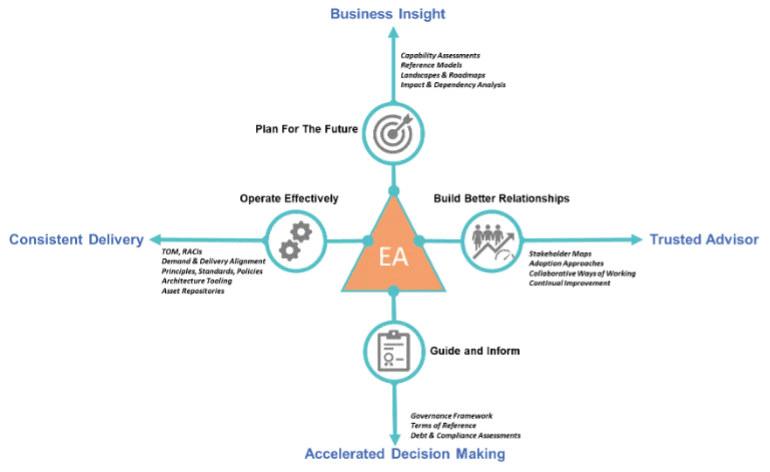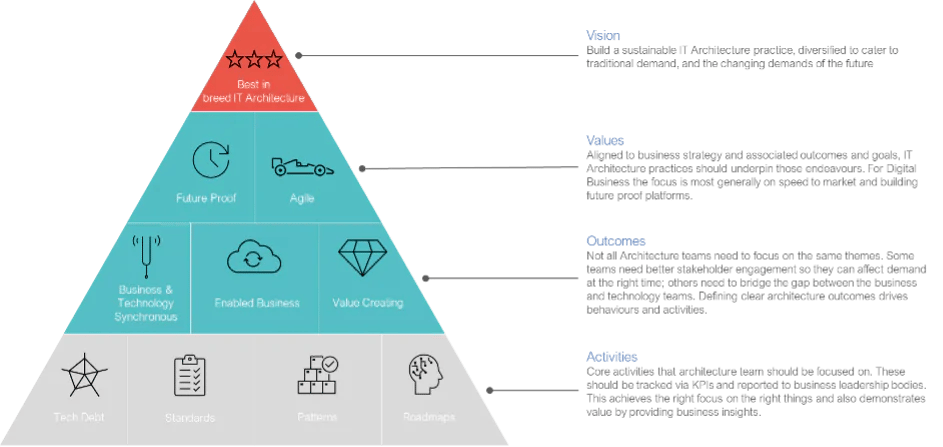
Digital IT Architecture Consulting
Architecture should add value by providing business and technology synchronicity, enabling business outcomes and creating value through future-proofing the organisation and focusing on enterprise agility. From an architecture perspective, this can be achieved by delivering business insight, ensuring consistency, accelerating decision making and fulfilling the trusted advisor role. At its core architecture is about planning for the future, advising how to operate efficiently, guiding decision making while building strong business and stakeholder relationships.

- IT Architecture is reflective of, and responsive to, business needs
- IT Architecture is an integral part of the business decision-making process
- IT Architects focus on the right things for your organisation.
- IT Architects know what they are responsible for and how to do it most effectively in your organisation
Digital Architecture
Digital architecture is a layered approach which when successful creates a stable foundation of practice aligned to a vision and the outcomes expected for that particular business. Each business is different and therefore the outcomes expected from the architecture teams are different; we regularly see teams adopt standard architecture methods and practices but they just cannot work successfully unless adjusted and made relevant for the organisation you are working in.
Digital Architecture is about making sure that you have agreed strategic capabilities that a business needs to affect the necessary change. By identifying what is strategic and what is not you can then look at how your people, processes and technology architecture are set up to support those strategic capabilities. Anything not strategic should either be stopped or if still a necessary part of business (e.g. cloud hosting) supported by suppliers with a focus on service excellence. A common mistake is for IT architecture teams to try and provide all technology services even if those services are not core to their business. An IT or digital architect needs to guide the business on what is important and what is not and focus resources and efforts on the things that differentiate the business, not the things that are commoditised.
 The Importance of Robust IT Architecture
The Importance of Robust IT Architecture
The role of an IT architect can encompass many aspects of IT: applications, integration, cloud, data, security, infrastructure. In many organisations, there are specialists in each of these fields with solution architects or lead technical architects taking on a coordinating role – bringing the different aspects of each together to provide a holistic view across domains/programmes or even for the whole enterprise. All of these aspects crucially cannot operate in isolation or in priority: the selection of applications cannot operate without an understanding of how it should be integrated into the enterprise, what and how it stores data, how it is secured and where is best to host it for scalability and reliability purposes. IT architecture done right brings all these elements together. Roadmaps, Landscapes, Standards, Patterns and Guidelines developed by the IT architect(s) enable an organisation to execute projects quickly and with little need for extensive decision making – the decisions have already been made and guardrails established allowing your product development and programme teams to execute delivery without the need to extensive oversight or governance. Without these artefacts – the bread and butter of robust IT architecture – generally chaos ensues and so does technical debt – which equates to a drain on resources and investment.
Future Flexibility
Building flexibility into IT services is a challenge that impacts all technology organisations. IT architecture has a critical role to play by providing the guardrails and advice that prioritise flexible services over monolith services which are difficult to change. Flexibility of IT services is a core principle in supporting digital transformation efforts. Digitisation brings the ability to continuously monitor services and gather feedback from customers (external or internal) and being able to respond or pivot quickly to support customer needs is a critical success factor in successful transformation efforts. IT teams struggle with flexibility even in the days of agile and DevOps.
Software Architecture
Successful software or application development teams need to adopt the latest application architecture approaches. Gartner has demonstrated a correlation between successful teams and the practices they employ: cloud-native, event-driven architecture, API Management to name a few. A lot of development teams see little value in architects or architecture as build rapid prototypes and focus on change during each sprint cycle or as part of a continuous pipeline of change. But ultimately, they still need what architects provide – guardrails which provide the signs to where to go and recommendations on how to get there – using standards, patterns and guidance notes to make sure the teams are working in a loosely coupled but aligned way – just like their code.
How Peru Can Help
We use architecture to build digital services that reflect, support and progress your business outcomes. Our clients typically have a need for swift, efficient and reliable operational execution; they want to achieve seamless and flexible extension of IT services everywhere – globally fit for use. We help by demonstrating best practice approaches to architecting for digital business and improving relationships with business stakeholders. We make sure our architects are experienced and that the delivered IT architecture consulting reflects and is responsive to business needs and is an integral part of the business decision-making process. All of our architects are focused on delivering business outcomes and our aim is to leave your teams with the right skills necessary to continue delivering Digital Architecture going forwards.